Comprehensive Assessment of Coalbed Methane Content Through Integrated Geophysical and Geological Analysis: Case Study from YJP Block
Abstract
1. Introduction
2. Geological Background
3. Analysis of Main Control Elements of 4 + 5 Coal Gas Content
3.1. Analysis of Role of Tectonic Conditions in Controlling Gas Content
- (1)
- A quantitative characterization of tectonic deformation was conducted by constructing deformation parameters through trend surface analysis.
- (2)
- We quantitatively characterized the degree of fault development in the region by calculating the fault dimension values using the cartridge dimension method.
3.2. Analysis of Role of Sedimentary Environment in Controlling Gas Content
3.3. Analysis of Role of Coal Seam Thickness in Controlling Gas Content
4. Coalbed Methane Content Prediction Based on Integrated Seismic–Geological Analysis
4.1. Weighting Analysis
4.2. Convergent Modeling
- (1)
- The Calculation of the Composite Coefficient (K):
- (2)
- The Calculation of the Gas Content Prediction:
4.3. Gas Content Prediction and Error Analysis
- (1)
- The CBM content prediction results from both methods showed a consistent trend, with the 4 + 5 coal’s CBM content decreasing from west to east. The two methods exhibited a strong correspondence, indicating that this method provided a good indication of the overall coalbed methane content changes in the coal seam.
- (2)
- The relative error in gas content prediction for all validated well sites using the integrated seismic–geologic method was less than 15%. In contrast, the relative error for most validation wells when using the traditional geological interpolation method exceeded 15%, reaching a maximum of 27.71%. This demonstrates that the proposed method was effective in predicting the gas content of the 4 + 5 coal in the study area, providing significantly improved accuracy compared to the traditional method. However, due to limitations in the quality of the logging and seismic data, large prediction errors for the local coalbed methane content persisted.
5. Conclusions and Future Directions
5.1. Conclusions
- (1)
- This research proposes a seismic–geological integrated analysis method based on key control elements to predict the gas content. The method was validated using data from the YJP block, where the error of the traditional difference method was 27.72% and the relative error between the wells not involved in the validation and the prediction results obtained using the method was controlled within 15%. This confirms the validity and feasibility of the method and its improved accuracy for coalbed methane content prediction.
- (2)
- The primary controlling elements influencing the gas content of the 4 + 5 coal in the study area were the tectonic conditions. Among these, the burial depth was positively correlated with the gas content, while the trend surface, dip, curvature, and fault dimension values were negatively correlated with the gas content. The coalbed methane content was generally higher in areas with negative residual values, such as syncline areas, and increased in areas with positive residual values, such as anticline areas. The correlation between the sedimentary environment, coal seam thickness, and gas content of the 4 + 5 coal was weak, indicating that these factors had a lesser impact on the gas content. Therefore, the tectonic conditions were the main controlling factor regarding the coalbed methane content.
5.2. Discussion
Author Contributions
Funding
Data Availability Statement
Conflicts of Interest
Appendix A
| WELL NAME | X (m) | Y (m) |
|---|---|---|
| L-01 | 507,295.01 | 4,270,530.35 |
| L-02 | 504,442.88 | 4,278,893.91 |
| L-03 | 507,774 | 4,267,297 |
| L-04 | 506,299.32 | 4,267,217.89 |
| L-05 | 508,015.39 | 4,270,659.41 |
| L-06 | 505,610.17 | 4,270,841.76 |
| L-07 | 507,927.03 | 4,273,349.1 |
| L-08 | 506,038.46 | 4,272,688.8 |
| L-09 | 507,103.37 | 4,277,830.9 |
| L-10 | 504,818.94 | 4,276,244.24 |
| L-11 | 507,076.88 | 4,280,699.22 |
| L-12 | 504,790.5 | 4,279,273.5 |
| L-13 | 508,056.4 | 4,278,042.7 |
| L-14 | 508,747 | 4,271,871 |
| L-15 | 510,232 | 4,279,717 |
| L-16 | 508,135 | 4,278,422 |
| L-17 | 511,767 | 4,279,119 |
| L-18 | 511,903 | 4,276,979 |
| L-19 | 509,328 | 4,278,267 |
| L-20 | 511,108 | 4,280,618 |
| L-21 | 511,737 | 4,276,363 |
| L-22 | 508,494 | 4,274,613 |
| L-23 | 511,520 | 4,271,952 |
| L-24 | 509,508 | 4,275,499 |
| L-25 | 509,663 | 4,279,727 |
| L-26 | 511,182 | 4,276,228 |
| L-27 | 508,652 | 4,273,938 |
| L-28 | 510,312 | 4,271,854 |
| L-29 | 507,988 | 4,281,095 |
| L-30 | 508,485 | 4,279,136 |
| L-31 | 512,227 | 4,274,848 |
| L-32 | 511,092 | 4,278,295 |
| L-33 | 508,247 | 4,275,479 |
| L-34 | 509,580 | 4,276,209 |
| L-35 | 511,023 | 4,275,677 |
| L-36 | 510,137 | 4,274,150 |
| L-37 | 510,168 | 4,276,191 |
| L-38 | 509,448 | 4,276,962 |
| L-39 | 508,487 | 4,276,932 |
| L-40 | 510,434 | 4,274,728 |
| L-41 | 512,085 | 4,279,798 |
| L-42 | 510,154 | 4,275,537 |
| L-43 | 509,544 | 4,281,142 |
| L-44 | 511,037 | 4,273,330 |
| L-45 | 510,334 | 4,281,376 |
| L-46 | 509,006 | 4,270,423 |
| L-47 | 510,884 | 4,268,024 |
| L-48 | 509,097 | 4,266,441 |
| L-49 | 511,495 | 4,267,210 |
References
- Su, X.B.; Liu, B.M. Occrrence state of coalbed methane and its influencing factors. J. Henan Polytech. Univ. (Nat. Sci.) 1999, 18, 157–160. [Google Scholar]
- Zou, C.; Yang, Z.; Huang, S.; Ma, F.; Sun, Q.; Li, F.; Pan, S.; Tian, W. Resource types, formation, distribution and prospects of coal-measure gas. Pet. Explor. Dev. 2019, 46, 451–462. [Google Scholar] [CrossRef]
- Li, Z.; Liu, D.; Ranjith, P.G.; Cai, Y.; Wang, Y. Geological controls on variable gas concentrations: A case study of the northern Gujiao Block, northwestern Qinshui Basin, China. Mar. Pet. Geol. 2017, 92, 582–596. [Google Scholar] [CrossRef]
- Chen, L.C.; Wang, S.W.; Sun, Q.P.; Xiao, Y.H.; Lv, S.F. Geomechanical characteristics and exploration and development technology of low-order coalbed methane in eastern Inner Mongolia Autonomous Region. Nat. Gas Ind. 2024, 44, 159–169. [Google Scholar]
- Li, J.; Tian, Z.B.; Shen, Y.Y.; Yang, X.D.; Cheng, H.H. Application of ovt domain prestack fissure prediction technology on CBM exploration in qinshui basin. Coal Geol. China 2021, 33, 67–72. [Google Scholar]
- Guo, Z.J.; Zha, L.Y.; Wu, Z.L. Prediction of coalbed methane-rich areas based on three-dimensional seismic data—A case study of the Dahe block in the Dahebian Trend, Guizhou. Nat. Gas Geosci. 2023, 34, 928–938. [Google Scholar]
- Wang, K.; Xiao, A.C.; Cao, T.; Zhang, R.H.; Wei, H.X.; Yu, C.F. Geologic structure and hydrocarbon exploration field of the northern tectonic zone of the Kuqa depression in the Tarim Basin. J. Geol. 2022, 96, 368–386. [Google Scholar] [CrossRef]
- Shen, Y.; Qin, Y.; Guo, Y.; Yi, T.; Yuan, X.; Shao, Y. Characteristics and sedimentary control of a coalbed methane-bearing system in lopingian (late permian) coal-bearing strata of western Guizhou Province. J. Nat. Gas Sci. Eng. 2016, 33, 8–17. [Google Scholar] [CrossRef]
- Fu, X.H.; Zhang, X.D.; Wei, C.T. Review of research on testing, simulation and prediction of coalbed methane content. J. China Univ. Min. Technol. 2021, 50, 13–31. [Google Scholar]
- Bustin, R.M.; Clarkson, C.R. Geological controls on coalbed methane reservoir capacity and gas content. Int. J. Coal Geol. 1998, 38, 3–26. [Google Scholar] [CrossRef]
- Zhang, Y.F.; Zhang, S.H.; Deng, Z.Y. A prediction method for coalbed methane development sweet spots based on gray relational clustering: Taking Shizhuangbei Block as an example. Coal Sci. Technol. 2024, 52, 166–175. [Google Scholar]
- Xiao, H.; Zhang, Z.S.; Guo, J.H.; Qin, R.B.; Yu, J. Coal structure identification method based on random forest combined with geophysical logging data and its application. Sci. Technol. Eng. 2021, 21, 10174–10180. [Google Scholar]
- Chen, T.; Zhang, Z.S.; Zhou, X.Q.; Guo, J.H.; Xiao, H.; Tan, C.Y.; Qin, R.B.; Yu, J. Prediction model of coalbed methane content based on well logging parameter optimization. Coal Geol. Explor. 2021, 49, 227–235, 243. [Google Scholar] [CrossRef]
- Chen, T.; Ding, H.K.; Zhang, Z.S.; Guo, J.H.; Tan, C.Y.; Zhou, X.Q.; Zhu, L.Q. Prediction model of CBM content based on logging data and optimized general vector machine. Saf. Coal Mines 2022, 53, 157–166. [Google Scholar]
- Sun, Y.; Zhang, J.; Wu, J.; Zhao, X.L.; Duan, C.L.; Fang, J.W. Application of seismic multi-attribute prediction technology to coal measure strata in the southern Ningwu Basin. Mud Logging Eng. 2022, 33, 121–125. [Google Scholar]
- Kędzior, S.; Kotarba, M.J.; Pękała, Z. Geology, spatial distribution of methane content and origin of coalbed gases in Upper Carboniferous (Upper Mississippian and Pennsylvanian) strata in the south-eastern part of the Upper Silesian Coal Basin, Poland. Int. J. Coal Geol. 2013, 105, 24–35. [Google Scholar] [CrossRef]
- Tian, Y.-P.; Yang, S.-A.; Yang, L.-X. Quantitative Analysis of Seismic Exploration for Gas Enrichment Area. Coal Technol. 2014, 33, 95–97. [Google Scholar]
- Li, W.; Shen, J.; Li, C.; Wen, R.D.; Su, Y.F. Occurrence conditions and development sweet spots prediction of deep coalbed methane in Yushe⁃Wuxiang block of Qinshui Basin. Pet. Geol. Oilfield Dev. Daqing 2023, 42, 9–19. [Google Scholar]
- Song, Y.; Liu, H.; Hong, F.; Qin, S.; Liu, S.; Li, G.; Zhao, M. Syncline reservoir pooling as a general model for coalbed methane (CBM) accumulations: Mechanisms and case studies. J. Pet. Sci. Eng. 2012, 88–89, 5–12. [Google Scholar] [CrossRef]
- Song, H.B.; An, H.L.; Liu, S.X.; Yu, Z.F.; Jin, Y.; Wang, B.Y.; Wang, C.Z. Controlling geological factors and coalbed methane enrichment areas in Southern Wuxiang Block, Qinshui Basin. J. China Coal Soc. 2021, 46, 3974–3987. [Google Scholar]
- Li, J. Prediction of coal seam gas content based on GRA-SSA-GRU model. Energy Environ. Prot. 2025, 47, 36–41. [Google Scholar] [CrossRef]
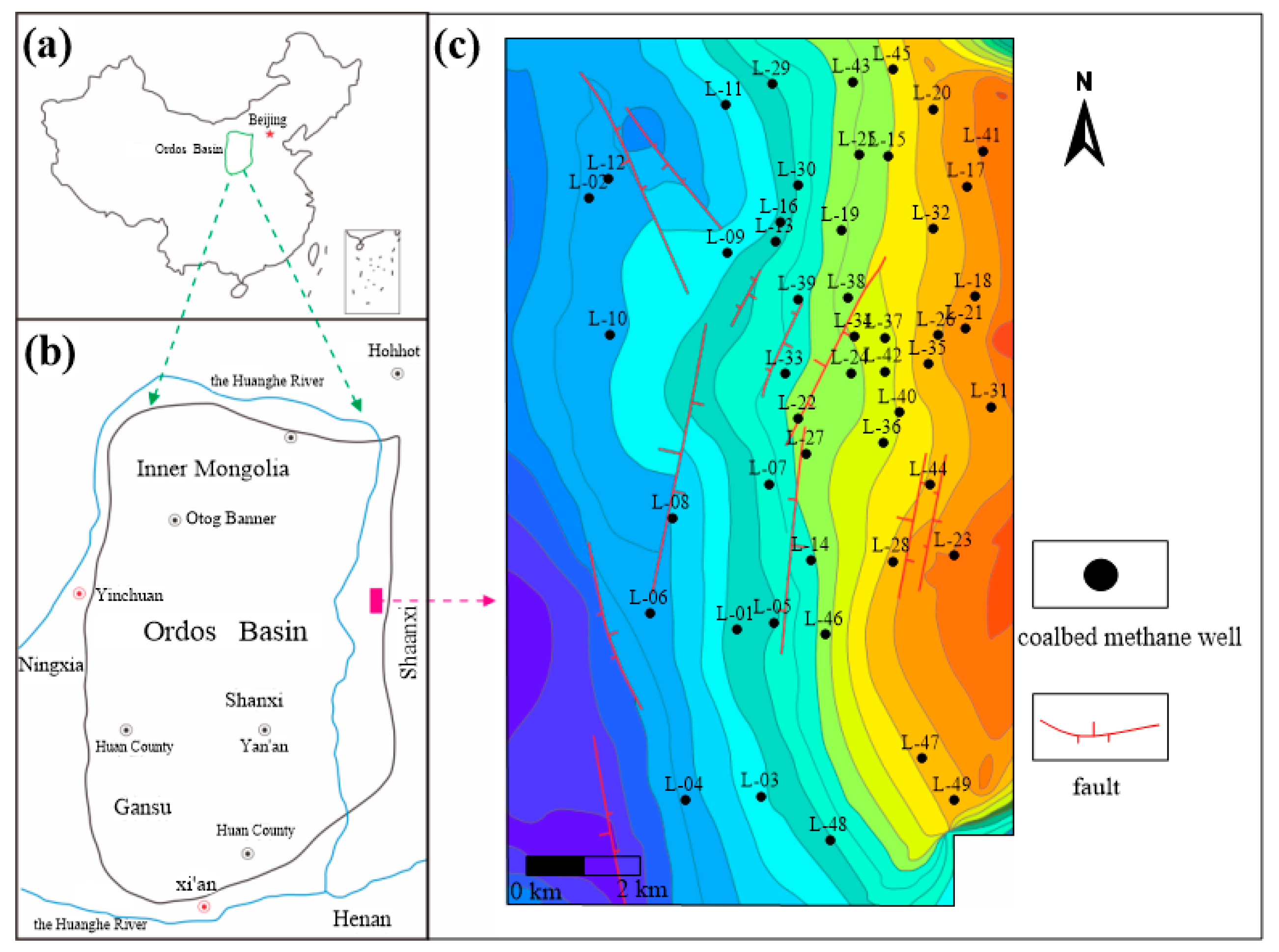
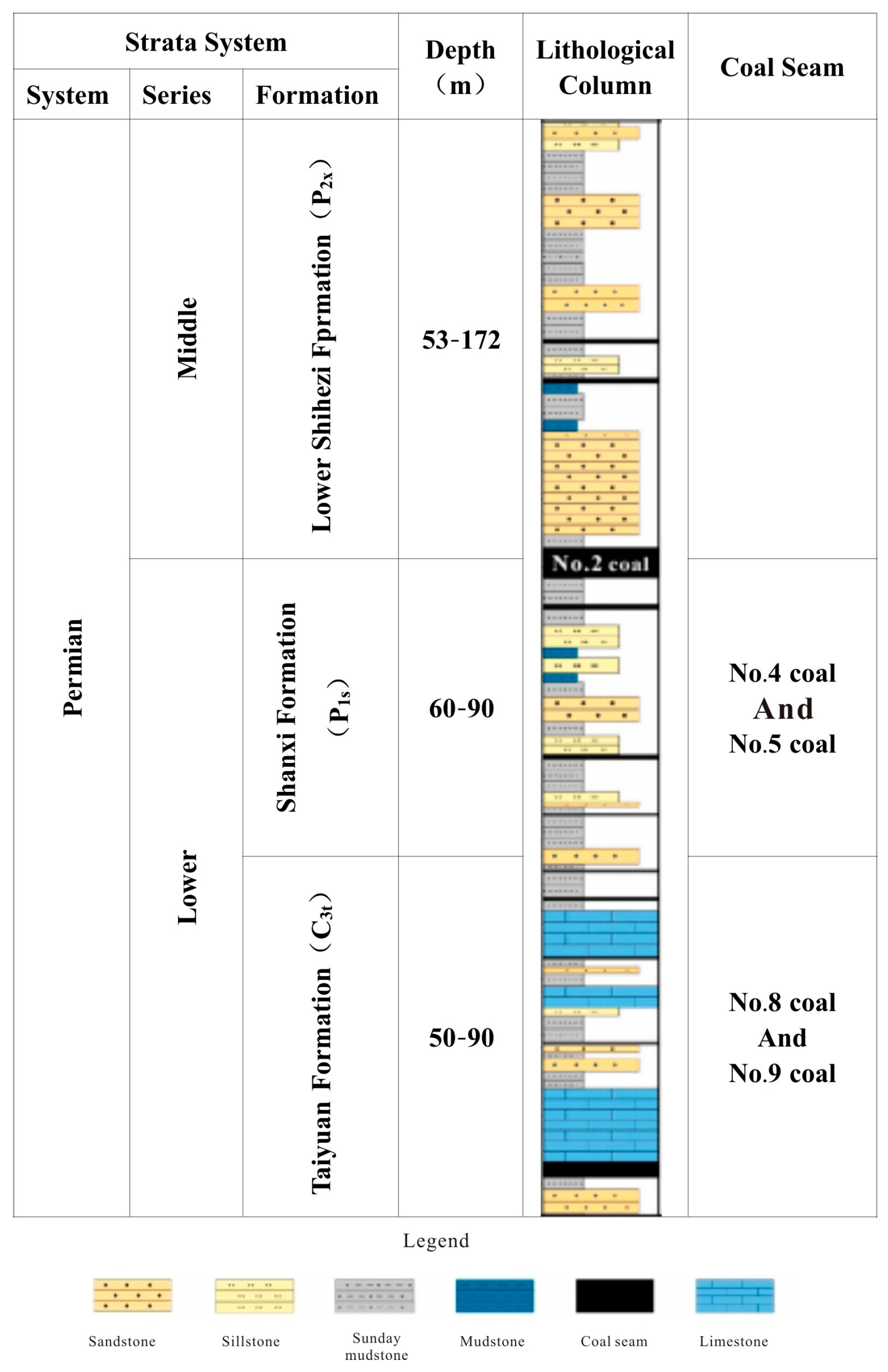
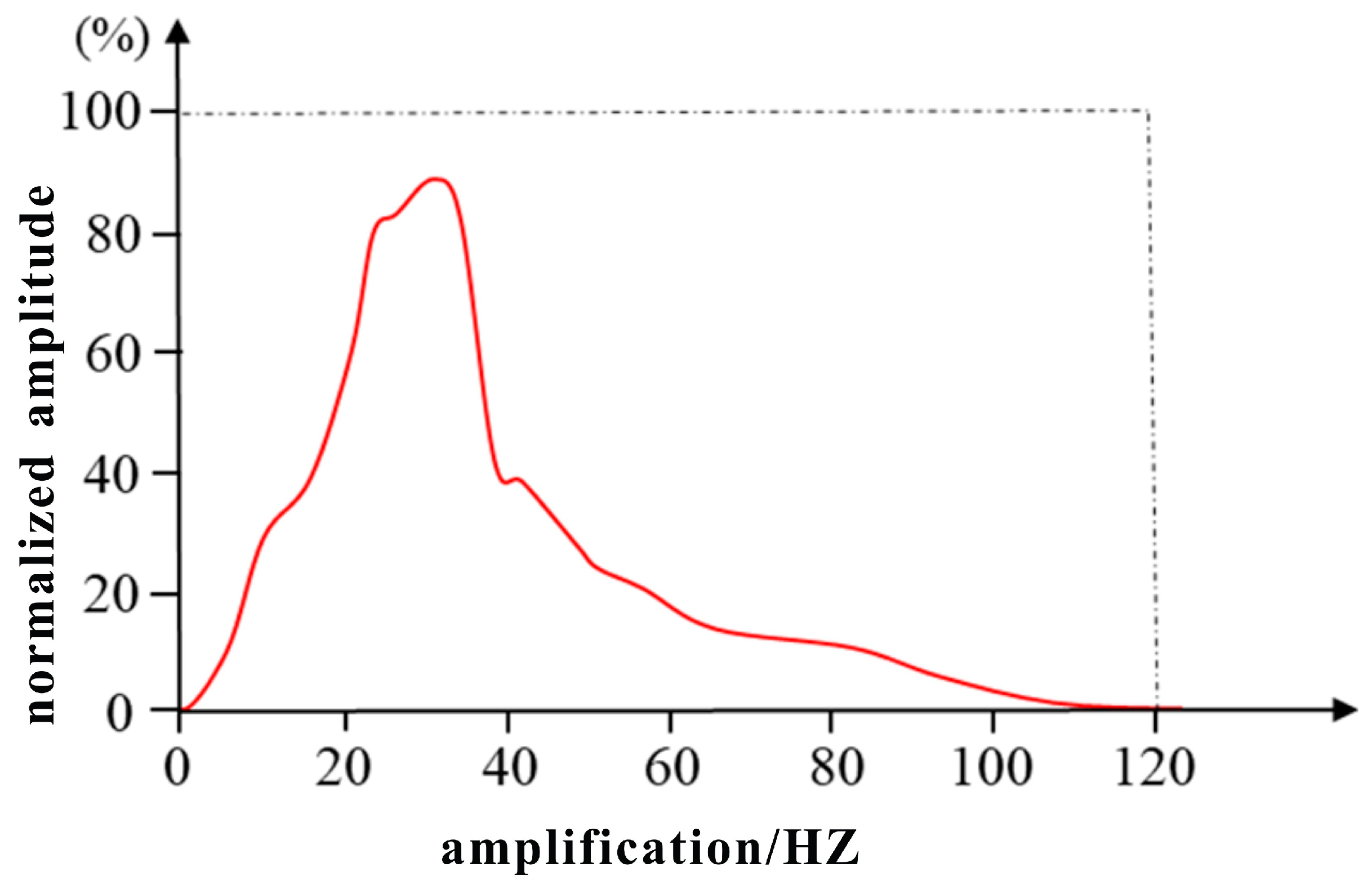

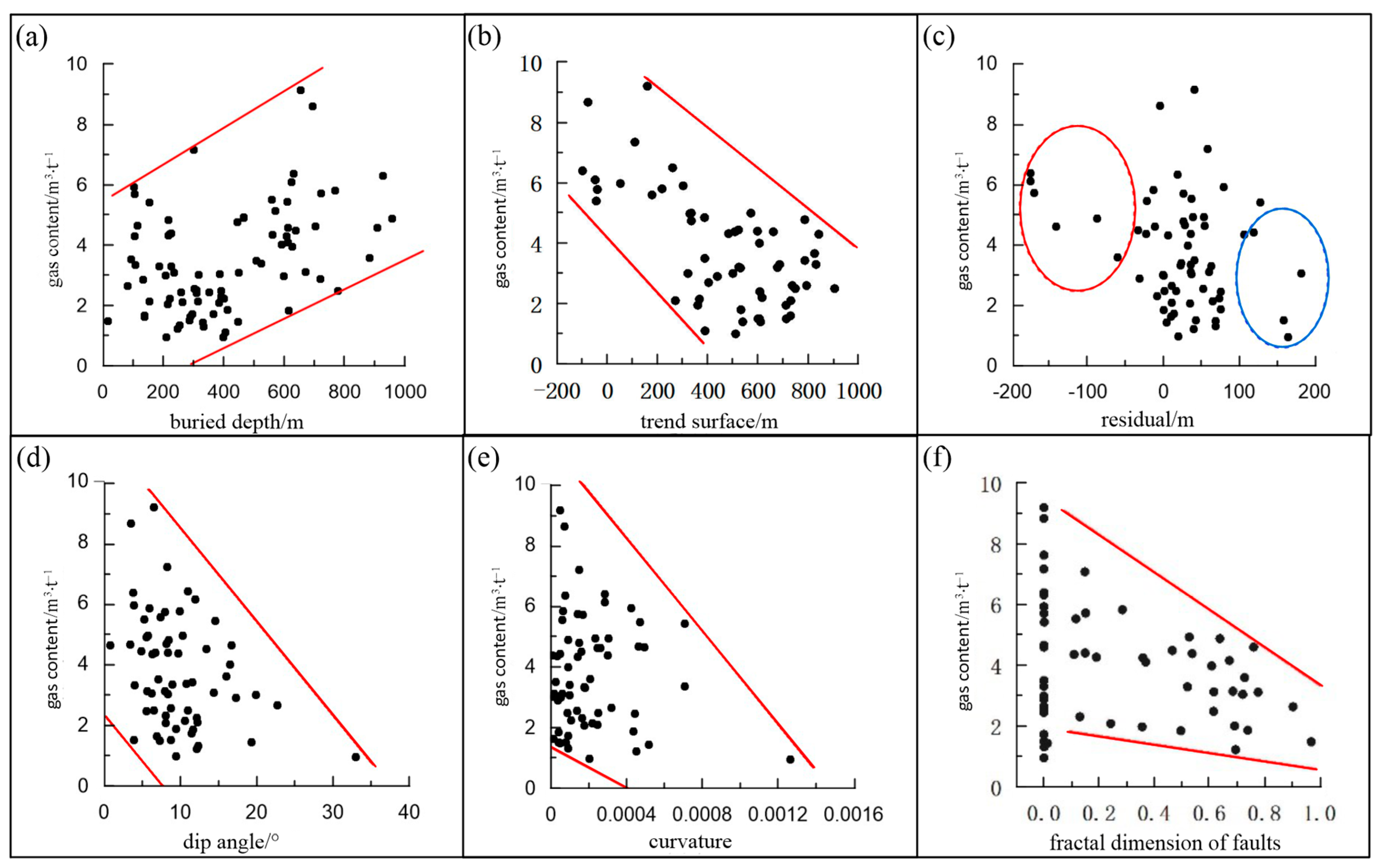

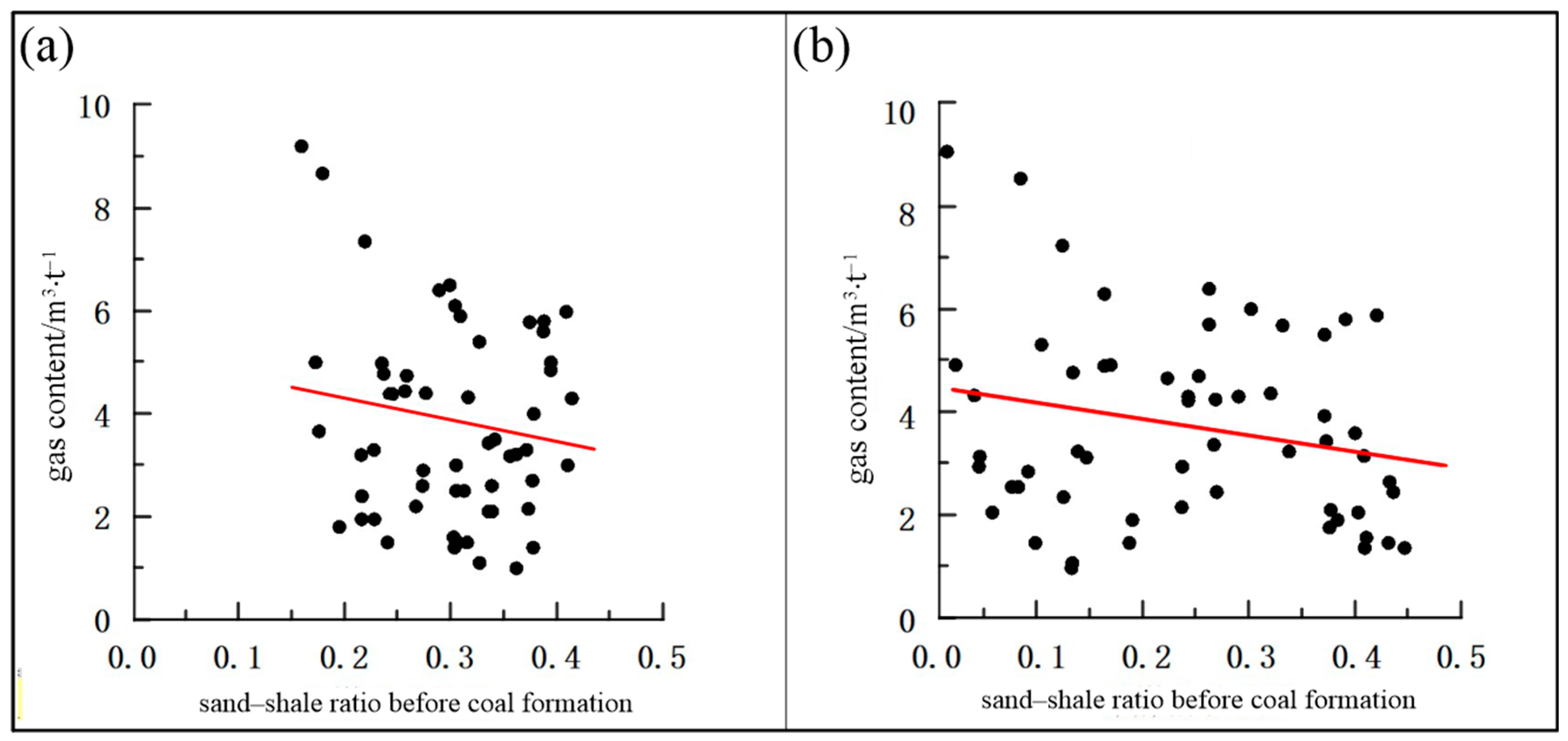


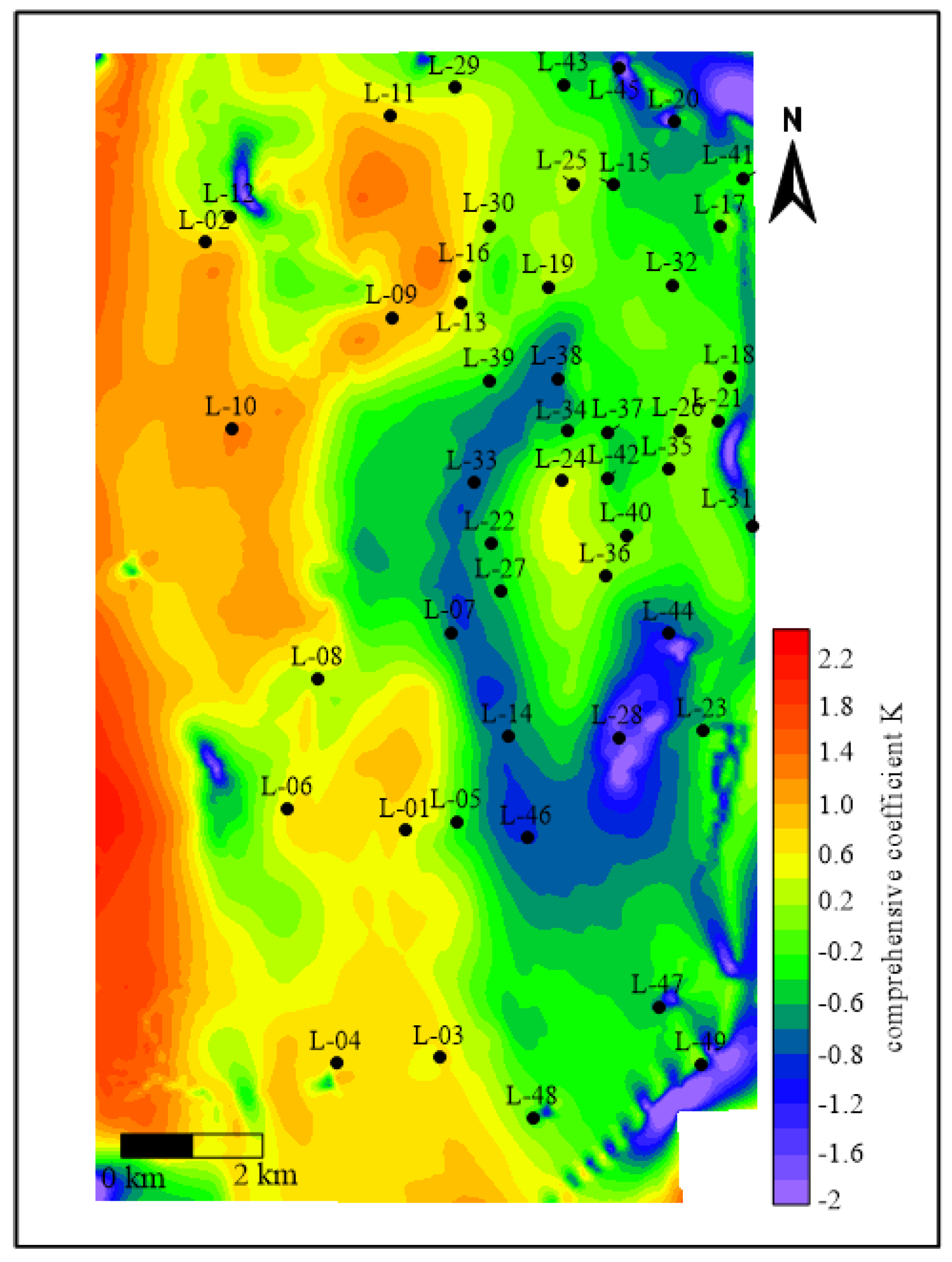

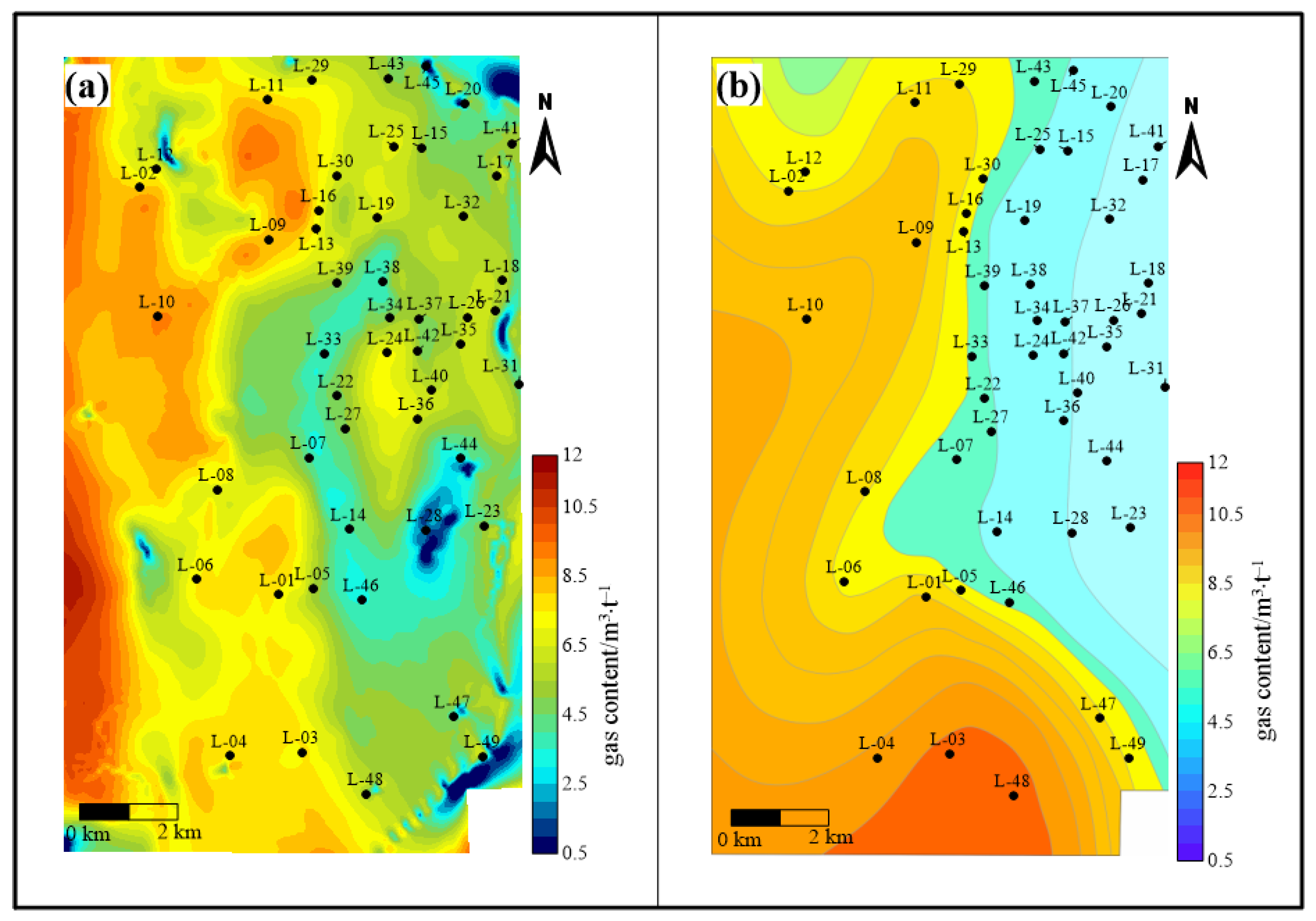
| Factor (x) | Relevance (a) | Arranged in Order | Weights | ||
|---|---|---|---|---|---|
| x5 | depth of burial | a5 | 0.796 | 1 | 0.20 |
| x1 | residual | a1 | 0.757 | 2 | 0.19 |
| x6 | trend surface | a6 | 0.670 | 3 | 0.17 |
| x2 | fault dimension (geology) | a2 | 0.634 | 4 | 0.15 |
| x3 | dip | a3 | 0.589 | 5 | 0.14 |
| x4 | curvature | a4 | 0.576 | 6 | 0.14 |
| Name of Well | Measured Gas Content/m3·t−1 | Seismic–Geological Integration Approach | Traditional Geological Interpolation | ||||
|---|---|---|---|---|---|---|---|
| Predicted Gas Content/m3·t−1 | Absolute Error/m3·t−1 | Relative Error | Predicted Gas Content/m3·t−1 | Absolute Error/m3·t−1 | Relative Error | ||
| L-101 | 10.11 | 9.01 | −0.5 | −4.94% | 11.76 | −1.65 | 16.32% |
| L-102 | 10.76 | 6.45 | −1.11 | −14.68% | 6.68 | −0.88 | −11.64% |
| L-103 | 4.33 | 9.89 | −0.87 | −8.09% | 7.76 | −2.13 | −19.80% |
| L-104 | 7.56 | 3.85 | −0.48 | −11.08% | 5.53 | 1.2 | 27.71% |
Disclaimer/Publisher’s Note: The statements, opinions and data contained in all publications are solely those of the individual author(s) and contributor(s) and not of MDPI and/or the editor(s). MDPI and/or the editor(s) disclaim responsibility for any injury to people or property resulting from any ideas, methods, instructions or products referred to in the content. |
© 2025 by the authors. Licensee MDPI, Basel, Switzerland. This article is an open access article distributed under the terms and conditions of the Creative Commons Attribution (CC BY) license (https://creativecommons.org/licenses/by/4.0/).
Share and Cite
Gao, K.; Chang, S.; Zhang, S.; Liu, B.; Liu, J. Comprehensive Assessment of Coalbed Methane Content Through Integrated Geophysical and Geological Analysis: Case Study from YJP Block. Processes 2025, 13, 1401. https://doi.org/10.3390/pr13051401
Gao K, Chang S, Zhang S, Liu B, Liu J. Comprehensive Assessment of Coalbed Methane Content Through Integrated Geophysical and Geological Analysis: Case Study from YJP Block. Processes. 2025; 13(5):1401. https://doi.org/10.3390/pr13051401
Chicago/Turabian StyleGao, Kaixin, Suoliang Chang, Sheng Zhang, Bo Liu, and Jing Liu. 2025. "Comprehensive Assessment of Coalbed Methane Content Through Integrated Geophysical and Geological Analysis: Case Study from YJP Block" Processes 13, no. 5: 1401. https://doi.org/10.3390/pr13051401
APA StyleGao, K., Chang, S., Zhang, S., Liu, B., & Liu, J. (2025). Comprehensive Assessment of Coalbed Methane Content Through Integrated Geophysical and Geological Analysis: Case Study from YJP Block. Processes, 13(5), 1401. https://doi.org/10.3390/pr13051401






